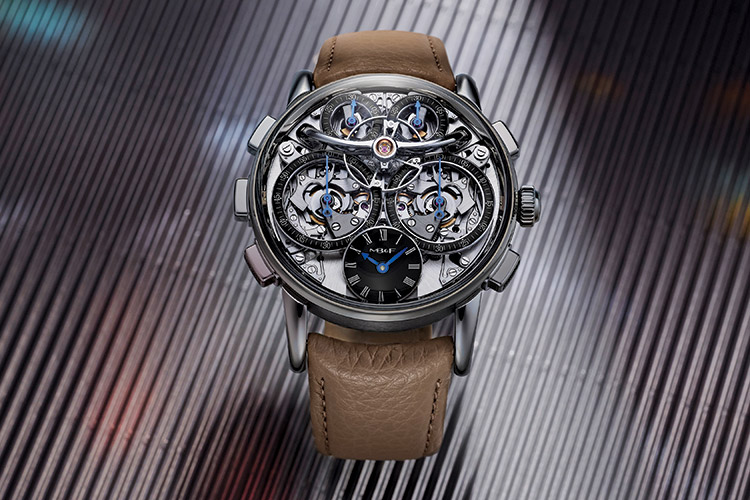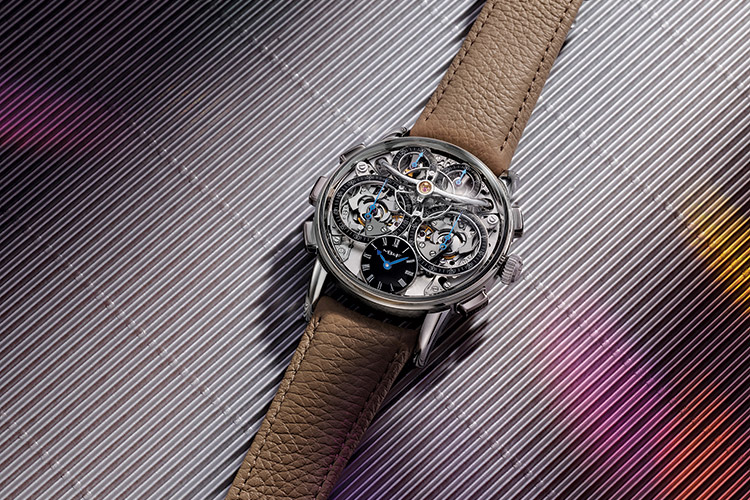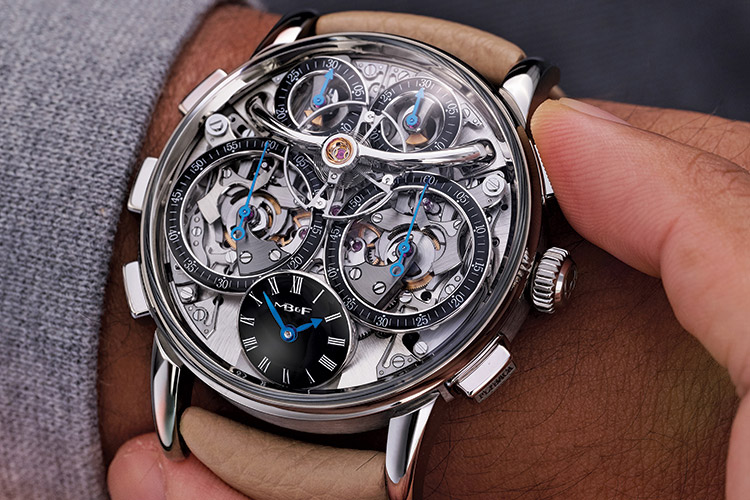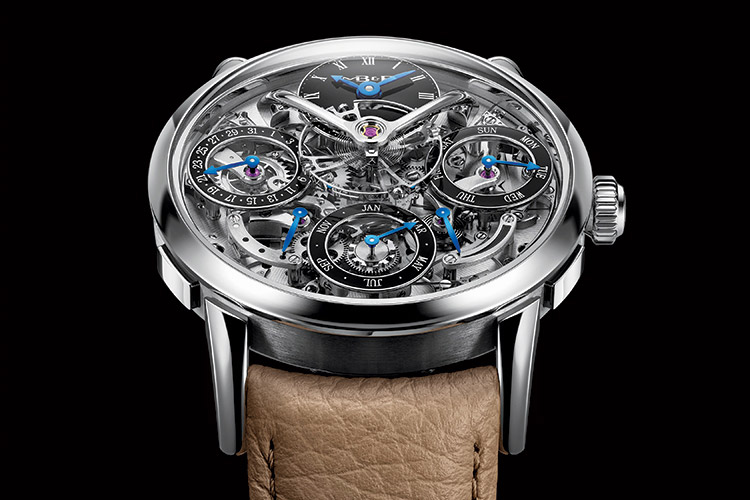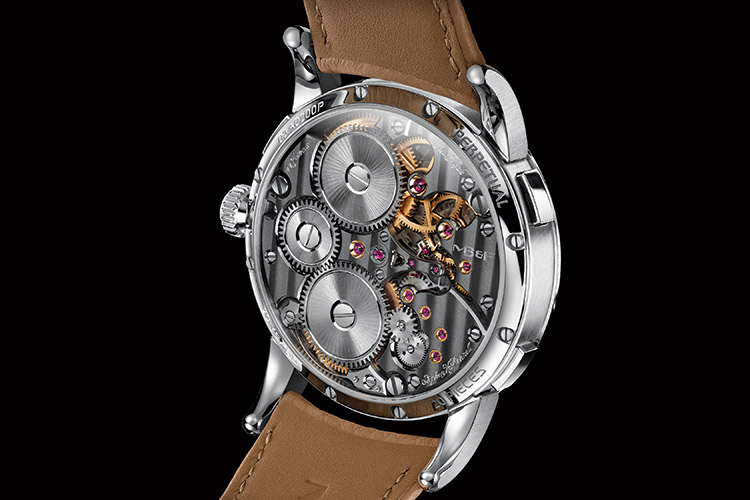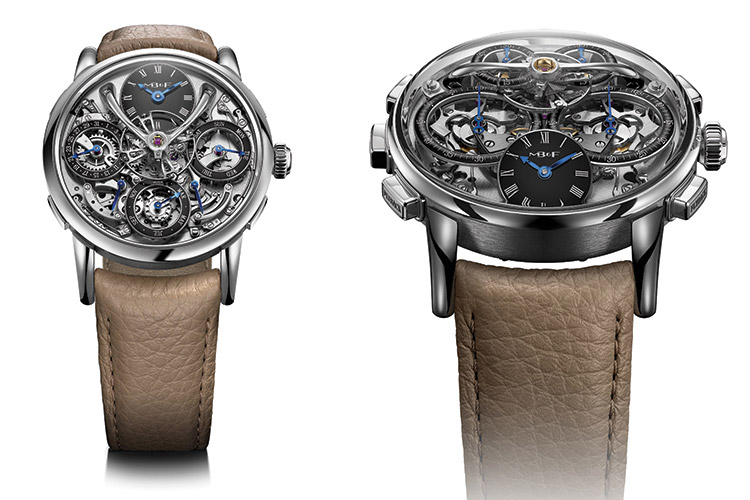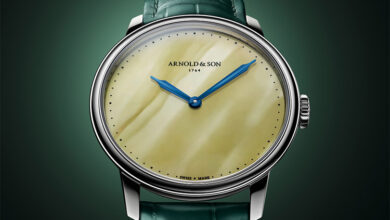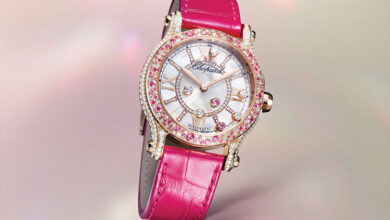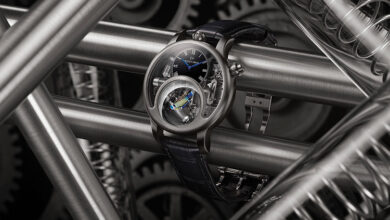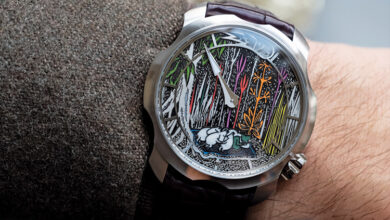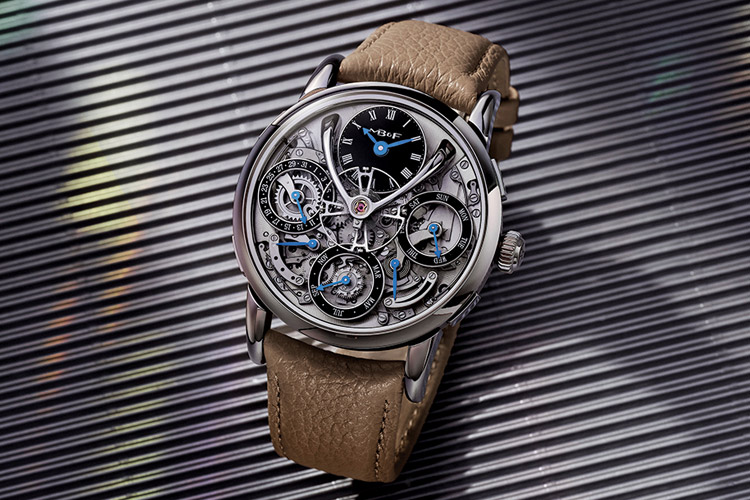
Horological concept laboratory and renowned independent watchmaker MB&F is celebrating its 20th anniversary in 2025. Founded in 2005, the haute horlogerie maison is kicking off its celebrations with two 20-piece Limited Edition “Longhorns” in stainless steel with rhodium-plated base plates, glossy black lacquer dials, and blued hands
MB&F’S 20th anniversary
2025 marks the 20th anniversary of an adventure that started in 2005 when Maximilian Büsser started putting together a network of “Friends”, on the basis of a drawing that we know now as Horological Machine No.1. Two decades and more than 20 calibres later, the MB&F team includes over 60 employees. This birthday year will be jam-packed with new timepieces, collaborations, and surprises that are a genuine celebration of the art of MB&F creativity, starting with two limited editions – the LM Perpetual Longhorn and the LM Sequential Flyback Longhorn – limited to just 20 pieces each.
The Longhorn adventure
The Longhorn concept was born in 2009 during the design phase of LM1, MB&F’s first Legacy Machine. The stylistic idea of playing with longer lugs – also called horns – was pleasing to the eye but problematic as where should the spring bar go: close to the case or at the tip of the lug? Depending on the wrist size, both options can lead to a bad fit. So, the long horns were switched for short horns and that was that, or so everyone thought.
Fast forward to 2021 and the 10th anniversary of the LM1. There were no LM1 timepieces left, since MB&F had made the decision to close the series. Just one prototype remained, potentially to mark this important milestone. But how could this timepiece be even more special than everything that had come before? It was at this moment that the question of the long horns was raised once more, but this time with the ingenious idea of drilling two holes in the lugs – one at the tip of the horn, the other closer to the case – so the customer could decide.
Where most of the LM1s were crafted in gold, platinum or titanium, this one-of-a-kind timepiece came in stainless steel – and instead of the Legacy Machines’ classic white sub dials, it featured glossy black dials against a rhodium-plated base plate. The black dials were a headache to create as even the smallest speck of dust would ruin them, but patience and perseverance prevailed.
The piece was sold at auction by Phillips in Association with Bacs & Russo with a significant portion of the proceeds going to Save the Rhino International, closing a chapter on the LM1. The incredible feedback following the sale, however, left a question about whether the long horns and this inversed black and silver colour scheme should end here.
The first two anniversary limited editions
They say that “all good things come to an end”, but if you can make them last a bit longer, why not seize the right opportunity? This was the thinking behind these first two anniversary timepieces featuring stainless steel cases, long horns, rhodium-plated base plates, glossy black lacquer sub dials and blued hands.
Legacy Machine Perpetual Longhorn
The first is the LM Perpetual Longhorn, containing MB&F’s GPHG award-winning perpetual calendar first released in 2015. Created in collaboration with independent watchmaker Stephen McDonnell, the 581-component, fully integrated and purpose-built movement eliminates the drawbacks of conventional perpetual calendars, offering a significantly more user-friendly and trouble-free solution.
McDonnell’s perpetual calendar relies on a ground-breaking “mechanical processor” that avoids skipping dates and jamming gears as the adjuster pushers automatically deactivate when the calendar changes. In this anniversary edition of 20 pieces, McDonnell’s visually stunning in-house movement takes on a whole new aesthetic with the addition of long horns and the black, silver and blue colourway.
First launched in 2015, the LM Perpetual has been since crafted in red gold, platinum, white gold, titanium, yellow gold, palladium and stainless steel. Beginning with a blank sheet of paper, MB&F and independent Irish watchmaker Stephen McDonnell completely reinvented that most traditional of horological complications: the perpetual calendar. The result is Legacy Machine Perpetual, featuring a visually stunning in-house movement – developed from the ground up to eliminate the drawbacks of conventional perpetual calendars.
The perpetual calendar is one of the great traditional complications, calculating the apparently random complexity of the varying numbers of days in each month − including the 29 days in February during leap years. But traditional perpetual calendars do have a few drawbacks: dates can skip; they are relatively easy to damage if adjusted while the date is changing; and the complications are usually compromises of modules powered by base movements.
The fully integrated, purpose-built movement of Legacy Machine Perpetual was designed from scratch for trouble-free use: no more skipping dates or jamming gears, and the adjuster pushers automatically deactivate when the calendar changes, so no problems there either.
Traditional perpetual calendar mechanisms use a 31-day month as the default and basically “delete” superfluous dates for the months with fewer days – by fast-forwarding through the redundant dates during changeover. A traditional perpetual calendar changing from February 28 to March 1 scrolls quickly through the 29th, 30th and 31st to arrive at the 1st.
LM Perpetual turns the traditional perpetual calendar system on its head by using a “mechanical processor” instead of the conventional space-consuming grand levier (big lever) system architecture. The mechanical processor utilises a default 28-day month and adds extra days as required. This means that each month always has the exact number of days required; there is no fast-forwarding or skipping redundant days. And while the leap year can only be set on traditional perpetual calendars by scrolling through up to 47 months, LM Perpetual has a dedicated quickset pusher to adjust the year.
Using an innovative system developed especially for Legacy Machine Perpetual, the subdials appear to “float” above the movement with no visible attachments. The skeletonised subdials rest on hidden studs, which is technically impossible with traditional perpetual calendar mechanisms because they would block the movement of the grand levier.
Taking a clockwise tour of the dial, at 12 o’clock we see the hours and minutes nestled between the elegant arches of the balance; day of the week at 3 o’clock, power reserve indicator at 4 o’clock, month at 6 o’clock, retrograde leap year indicator at 7 o’clock, and date at 9 o’clock. The Legacy Machine Perpetual won the Best Calendar Watch Prize at the GPHG in 2016.
Legacy Machine Sequential Flyback
The second limited edition, the LM Sequential Flyback Longhorn, was also conceived by Stephen McDonnell. The first version of the series, the LM Sequential EVO, was first released in 2022 and was MB&F’s first-ever chronograph – and 20th calibre. It featured significant technical innovations and an unprecedented combination of timing modes thanks to its “Twinverter” binary switch, allowing independent timing, split-second, cumulative and lap-timer modes – going on to win watchmaking’s ultimate prize, the coveted Aiguille d’Or award.
The Flyback version went even further than the EVO edition as, on top of the previous timing modes, typically associated with motor racing, it added the flyback function originally conceived for pilots, bringing the Sequential into the world of aviation. Now adorned with long horns, blued hands and glossy black sub dials, this second limited edition of 20 pieces is also ready to kick off MB&F’s 20th birthday celebration.
The design of the LM Sequential is completely unique. It encompasses two independent chronographs within a single movement, both of which are linked to a common escapement and oscillator, but the energy losses would be doubled, resulting in unacceptably poor performance. All this functionality within a single watch required the invention of a fundamentally new type of chronograph system, one which would not be susceptible to any sort of energy losses.
This is exactly what the LM Sequential does, thanks to the use of its innovative internally jewelled vertical clutches and their associated control system. The new flyback mechanisms also incorporate jewelled rollers. Thanks to these patented solutions, the Sequential calibre outperforms conventional chronographs in terms of energy efficiency and precision.
The LM Sequential Flyback offers an unprecedented combination of timing modes, thanks to its revolutionary Twinverter pusher.
Independent Mode – Because of this, each of the two chronographs can be set to time two entirely different events.
Simultaneous or Split-Second Mode – The Twinverter allows the wearer to start both chronographs at exactly the same time, but the different end times can be easily recorded by pressing each chronograph’s individual start/stop pusher. Also, the durations of the events can exceed 60 seconds, which is the limit for the vast majority of split-second chronographs on the market.
Cumulative Mode – By starting one chronograph when a person begins working on one task and then using the Twinverter when they shift focus to the second task (switching again when they go back to the first), it is easy to track the amount of time cumulatively spent on each task. Another example of this usage is the timing of a chess match.
Sequential Mode (or Lap-Timer Mode) – For those timing competitive sports, this mode can be used to measure individual lap times. Starting one chronograph at the beginning of an event and using the Twinverter upon the completion of a lap instantly launches the second chronograph in order to time the next lap, while the first chronograph is stopped, allowing ample time for the timing result to be noted down. The stopped chronograph can then be reset to zero, ready to be relaunched with the Twinverter for the following lap. Thanks to its minutes’ totalisers, the LM Sequential can be used effectively in sporting events with average lap times of over a minute (which includes the vast majority of motor sports).
Flyback Mode – The flyback was originally developed in the 1930s for airplane pilots, allowing stop, reset, and restart to be done simultaneously in a single press on the reset pusher. Combining the new flyback function with the other timing modes of the Sequential calibre offers even more functionality. For example, a pilot can keep track of overall flight time on one chronograph, while using the other chronograph to accurately time each leg with the flyback function.
A tribute to a special friend
MB&F and Stephen McDonnell are inextricably linked and therefore MB&F decided to start its 20th-anniversary celebrations with his calibres, which are some of the most complicated movements in the MB&F collection. These two Longhorn limited editions are just the beginning of a year of celebrations dedicated to MB&F’s many collaborations and creations, so stay tuned for more over the coming months.
